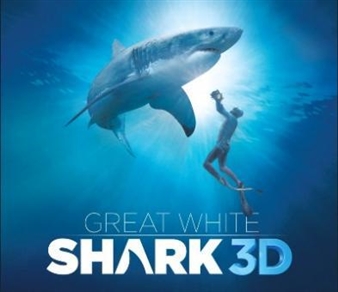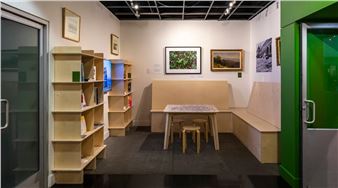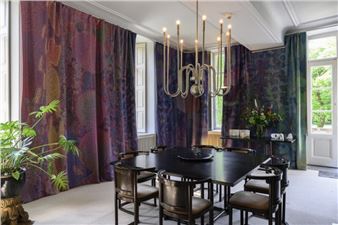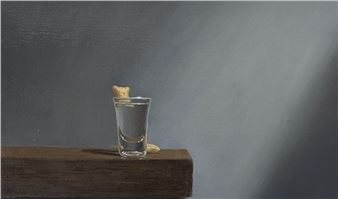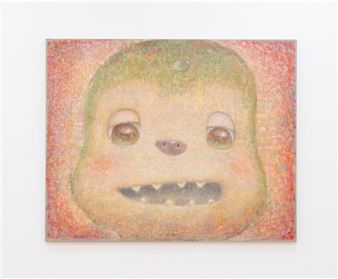Elizabeth C. Moran: Backward ran sentences until reeled the mind
Cuchifritos Gallery + Project Space is pleased to present Backward ran sentences until reeled the mind, a solo show of recent work by Elizabeth Moran.
Since June 2017, Moran has researched the history of fact-checking as a profession. The position was created by TIME MagazineвҖҷs founders in 1923, and as the first weekly news magazine in the US, TIME served as an aggregator, culling stories from 300 newspapers. TIMEвҖҷs reporting was advertised as вҖңwritten after the most thorough and exhaustive scrutiny of news-sources;вҖқ however, this вҖңexhaustive scrutinyвҖқ was considered womenвҖҷs work from its inception. Indeed, early fact-checking manuals include instructions to confirm names, dates, etc., while the checkers maintain their вҖңdomestic list of chores.вҖқ Darning socks and facts. Ironing shirts and statements.
According to the artistвҖҷs ongoing research, each advertisement from the publicationвҖҷs first year in existence often relied on absurd metaphorsвҖ”like вҖңCatch 100 baseballs with a seven-bushel crab netвҖқвҖ”and the use of male pronounsвҖ”like вҖңHe cut the Gordian KnotвҖқвҖ”to describe the work done by the women fact-checkers. Using these advertisements as a point of departure, Moran composes tableaus with found objects and office materials from the 1920s, including a typesetterвҖҷs drawer, letter opener, and telephone receiver. With a surrealist approach (The Surrealist Manifesto was published just one year following the launch of TIME magazine), Moran ultimately documents the efforts of an invisible class by creating a series of potentially confusing images that visualize TIMEвҖҷs absurd language describing the womenвҖҷs labor.
MoranвҖҷs latest series interrogates the historical association between womenвҖҷs work and fact-checking, particularly within todayвҖҷs вҖңpost-factвҖқ information landscape. Drawing from the earliest advertisements for TIME magazine, MoranвҖҷs photographs and sculptures give rare voice to these once-anonymous women.
In parallel, Moran has been experimenting with carbonless paper both as a material and as a proxy for the simultaneous presence and absence of these women and their work. Indeed, fact-checkers used carbonless paper when typing-up manuscripts, so the copies (the вҖңpinksвҖқ and вҖңyellowsвҖқ) could be distributed to TIMEвҖҷs staff. The material responds to pressure, similarly to how photographic paper responds to light, resulting in ghostly imprints of information or touch.

Recommended for you
Cuchifritos Gallery + Project Space is pleased to present Backward ran sentences until reeled the mind, a solo show of recent work by Elizabeth Moran.
Since June 2017, Moran has researched the history of fact-checking as a profession. The position was created by TIME MagazineвҖҷs founders in 1923, and as the first weekly news magazine in the US, TIME served as an aggregator, culling stories from 300 newspapers. TIMEвҖҷs reporting was advertised as вҖңwritten after the most thorough and exhaustive scrutiny of news-sources;вҖқ however, this вҖңexhaustive scrutinyвҖқ was considered womenвҖҷs work from its inception. Indeed, early fact-checking manuals include instructions to confirm names, dates, etc., while the checkers maintain their вҖңdomestic list of chores.вҖқ Darning socks and facts. Ironing shirts and statements.
According to the artistвҖҷs ongoing research, each advertisement from the publicationвҖҷs first year in existence often relied on absurd metaphorsвҖ”like вҖңCatch 100 baseballs with a seven-bushel crab netвҖқвҖ”and the use of male pronounsвҖ”like вҖңHe cut the Gordian KnotвҖқвҖ”to describe the work done by the women fact-checkers. Using these advertisements as a point of departure, Moran composes tableaus with found objects and office materials from the 1920s, including a typesetterвҖҷs drawer, letter opener, and telephone receiver. With a surrealist approach (The Surrealist Manifesto was published just one year following the launch of TIME magazine), Moran ultimately documents the efforts of an invisible class by creating a series of potentially confusing images that visualize TIMEвҖҷs absurd language describing the womenвҖҷs labor.
MoranвҖҷs latest series interrogates the historical association between womenвҖҷs work and fact-checking, particularly within todayвҖҷs вҖңpost-factвҖқ information landscape. Drawing from the earliest advertisements for TIME magazine, MoranвҖҷs photographs and sculptures give rare voice to these once-anonymous women.
In parallel, Moran has been experimenting with carbonless paper both as a material and as a proxy for the simultaneous presence and absence of these women and their work. Indeed, fact-checkers used carbonless paper when typing-up manuscripts, so the copies (the вҖңpinksвҖқ and вҖңyellowsвҖқ) could be distributed to TIMEвҖҷs staff. The material responds to pressure, similarly to how photographic paper responds to light, resulting in ghostly imprints of information or touch.
Artists on show
Contact details


 ARTISTS
ARTISTS









